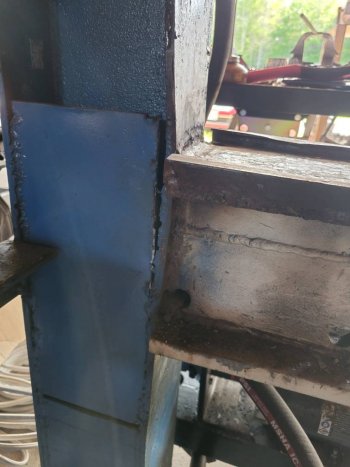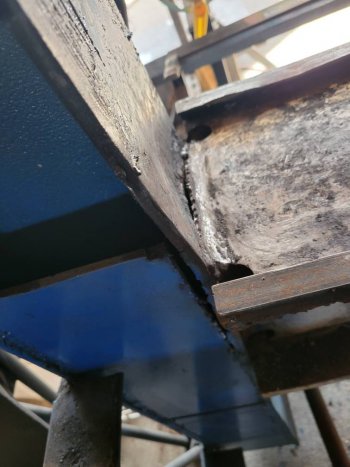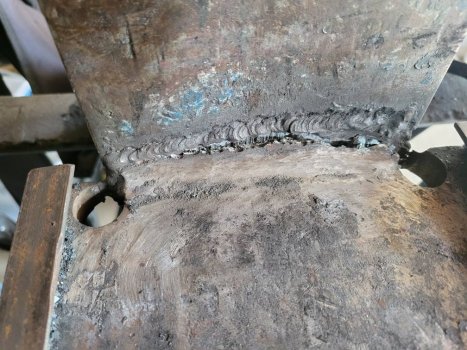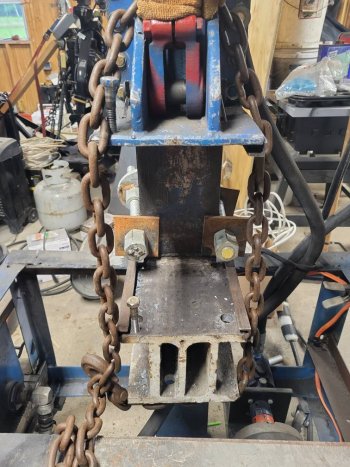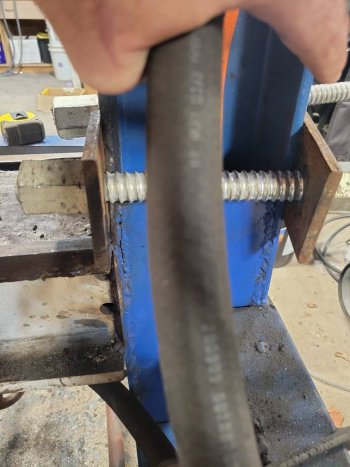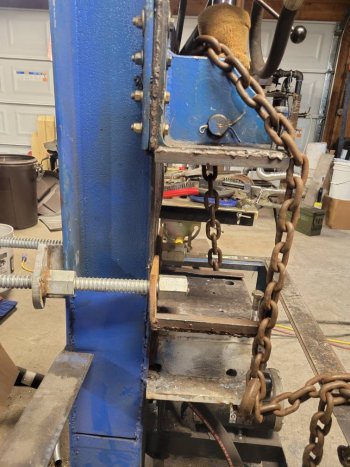You are using an out of date browser. It may not display this or other websites correctly.
You should upgrade or use an alternative browser.
You should upgrade or use an alternative browser.
Well.... that sucks.
- Thread starter tomang07
- Start date
bladegrinder
Well-Known Member
Looks like some bad welds.
Bruce McLeish
Well-Known Member
Damn , man. You lucky gringo. Didn't get hurt.
Doug Lester
Well-Known Member
Glad you walked away from it.
Doug
Doug
tomang07
Active Member
The guy who built it claimed it was a 30 ton, not honestly sure.Bummer - glad you weren't hurt. The welds look like they didn't penetrate very deep. Is there any support below? OR, just that butt weld?
What tonnage are you using? size of cylinder and PSI?
Clearly the welds aren't great. As far as support, not really, the lower platform/die holder were welded to the I beam.
I think it let go right behind the lower die plate first, I noticed my billet was "banana-ing" a bit, that's when I heard it pop and the rest is obvious.
I'm kinda at a loss for what to do. I could try to fix it. But being structurally compromised I don't think that's safe. Not really set up for heavy metal fab.
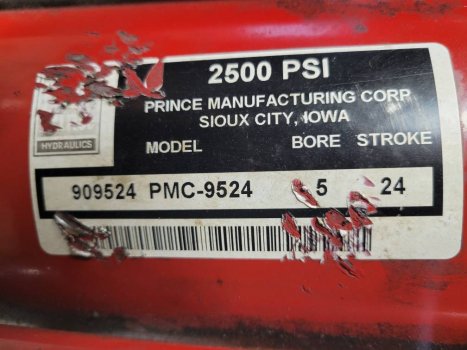
Sent from my SM-G991U using Tapatalk
Chris Railey
Well-Known Member
That would really hurt my feelings too. I would check around locally for a professional welder and see if he/she thinks it can be fixed. Its amazing what a “real welder” can do with steel.
Does the system have a pressure gauge so you can see the actual pressure? I see it's a 5" bore cylinder - big 'un for sure. unlikely it's a 30 ton as the cylinder is only rated for 2500 psi. No way to tell what the actual operating pressure is. With the 5" bore cylinder operating at a max pressure of 2500 psi would be 24.5 ton. It would take 3100 psi to get up to the 30 ton mark.
As Chris says, it's amazing what a "real welder" can do repairing steel. It looks like the welds gave before any of the steel has much damage. Even where that I-Beam bent a tad should be fixable with a bit of bracing welded in.
As Chris says, it's amazing what a "real welder" can do repairing steel. It looks like the welds gave before any of the steel has much damage. Even where that I-Beam bent a tad should be fixable with a bit of bracing welded in.
Daniel Macina
Well-Known Member
Looks salvageable but probably need a professional welder as it’s going to take some fairly heavy repairs also looks like it needs to be reinforced in a few areas. Not sure what your budget is but it might be worth it to just chalk it up to a lesson learned and get a new one from a trusted seller.
I just picked up on the very first sentence in the OP, setting the weld shouldn't have had all that much pressure on the press.Setting the weld on a 256 layer damascus billet and press went POP!
"Reinforced" - that's the word I was looking for in early post, welds are shallow, and it looks like it's missing some much needed reinforcement at key points on the frame. Too much good stuff to junk the whole press - all the hydraulic system should be good.
tomang07 What part of the world are you in?
interesting design. However, if you rebuild that one the shelf needs a support post under it. Each time you used it the press was applying a downward rotating pressure to the shelf. The farther out your dies from the upright the amount of rotational torgue is increased. Kinda like a diving board. Only in this case you are applying 25-30 tons of pressure to the diving end of a diving board. You got lucky!
bladegrinder
Well-Known Member
I hate to say this but all the welds that can be seen in your pictures look unacceptable, I’d have someone who welds for a living look that whole press over and see what his opinion is, maybe he can grind them down and go over them. For a machine that operates under stresses like your press there’s no place for crappy welds.
Again, be sure to get a welder who is familiar with welding heavy material for the repair. There is no way to pull that all back together with metal cold. You'll need to strip everything from the frame and start over. Not a big deal, just time consuming - and time is money.
Would you mind stepping back to give a couple of photos of the full press frame? Those closeups of the welds show the crappy welds, but not really how the frame is designed and put together. Looks like it's a "C" type frame? That design surely does put LOTS of stress on the single column.
Is there a pressure gauge on the system? If so, any idea of max pressure the system is set at?
Would you mind stepping back to give a couple of photos of the full press frame? Those closeups of the welds show the crappy welds, but not really how the frame is designed and put together. Looks like it's a "C" type frame? That design surely does put LOTS of stress on the single column.
Is there a pressure gauge on the system? If so, any idea of max pressure the system is set at?
Daniel Macina
Well-Known Member
Don’t wanna be that guy but aside from the bad welding it looks like a fairly dangerous design because it is not built properly I would salvage what you can from it and maybe have a welder weld you up a new frame more than likely you could still use all the hydraulic system if that was all put together correctly.
tomang07
Active Member
No pressure gauge, it's a converted log splitter. I purchased it along with a bunch of other tools from a smith who closed his shop. I'll snap some pics shortly.Again, be sure to get a welder who is familiar with welding heavy material for the repair. There is no way to pull that all back together with metal cold. You'll need to strip everything from the frame and start over. Not a big deal, just time consuming - and time is money.
Would you mind stepping back to give a couple of photos of the full press frame? Those closeups of the welds show the crappy welds, but not really how the frame is designed and put together. Looks like it's a "C" type frame? That design surely does put LOTS of stress on the single column.
Is there a pressure gauge on the system? If so, any idea of max pressure the system is set at?
Sent from my SM-G991U using Tapatalk
Just saw your post as I was typing below.
It "looks" like the only damage is to the I-Beam section where the bottom die holder was welded to. That will be fairly easy for a welder to cut bottom die holder off the I-beam so the I-beam can be straighten and repaired. Then weld the bottom die holder back to I-beam, and again ADD a support below the bottom die holder so pressure from the ram is not putting a torque on the I-beam. Once the welder has the bottom die holder repaired with all the required supports, then have him go over ALL the welds to make them good welds. He might have to grind them out so the new welds can penetrate the steel. Those existing welds look like they're just "laying" on top of the steel with very little penetration. A good welder will be the person to make the call when he's looking at the press.
First and MOST important is to install a pressure gauge either in the high pressure line from pump to control valve, OR in the line from control valve to top of cylinder. Either place works, and I don't have the knowledge to say which it should be. The line from pump to control valve will give pressure both in pressing and retracting the cylinder while the line from control valve to top of cylinder will give only pressing down.
Since that ram is rated at 2500 psi a 3,000 psi gauge would be good. Here's the gauge i used: https://www.amazon.com/dp/B00FBKT9P6 Once the pressure gauge is installed you can set the max pressure on the control valve down to 2,000 psi to give a max of 20 tons. Any fittings used be sure they are rated for hydraulic service.
Good photos showing how the press is designed. Those were before the damage?
I didn't mean to run on so much, but got to typing. Remember, ONLY a good welder with knowledge of welding can really make the call.
edit: a bit more, that must have been some log splitter used to make that press. Looking at how long that I-beam is above the lower die holder I would really watch any flex in that top portion. I'm not sure I'd be comfortable with a full 25 ton, but by adjusting the control valve to a lower pressure the tons can be limited to a safe level before any flex shows.
Since the lower die bracket broke while setting the welds on a billet it's likely the pressure was only in the 10 ton range. It doesn't take much pressure to set the welds. Even my little Coal Iron 12 ton press that only put out 8 tons (Coal Iron's 12 ton press is designed to provide 9 ton) didn't use full pressure to set welds. Had I put the full 8 tons of pressure it would have mashed the billet flat. Of course the small dies my press uses will take much less pressure than the large dies used in your press.
It "looks" like the only damage is to the I-Beam section where the bottom die holder was welded to. That will be fairly easy for a welder to cut bottom die holder off the I-beam so the I-beam can be straighten and repaired. Then weld the bottom die holder back to I-beam, and again ADD a support below the bottom die holder so pressure from the ram is not putting a torque on the I-beam. Once the welder has the bottom die holder repaired with all the required supports, then have him go over ALL the welds to make them good welds. He might have to grind them out so the new welds can penetrate the steel. Those existing welds look like they're just "laying" on top of the steel with very little penetration. A good welder will be the person to make the call when he's looking at the press.
First and MOST important is to install a pressure gauge either in the high pressure line from pump to control valve, OR in the line from control valve to top of cylinder. Either place works, and I don't have the knowledge to say which it should be. The line from pump to control valve will give pressure both in pressing and retracting the cylinder while the line from control valve to top of cylinder will give only pressing down.
Since that ram is rated at 2500 psi a 3,000 psi gauge would be good. Here's the gauge i used: https://www.amazon.com/dp/B00FBKT9P6 Once the pressure gauge is installed you can set the max pressure on the control valve down to 2,000 psi to give a max of 20 tons. Any fittings used be sure they are rated for hydraulic service.
Good photos showing how the press is designed. Those were before the damage?
I didn't mean to run on so much, but got to typing. Remember, ONLY a good welder with knowledge of welding can really make the call.
edit: a bit more, that must have been some log splitter used to make that press. Looking at how long that I-beam is above the lower die holder I would really watch any flex in that top portion. I'm not sure I'd be comfortable with a full 25 ton, but by adjusting the control valve to a lower pressure the tons can be limited to a safe level before any flex shows.
Since the lower die bracket broke while setting the welds on a billet it's likely the pressure was only in the 10 ton range. It doesn't take much pressure to set the welds. Even my little Coal Iron 12 ton press that only put out 8 tons (Coal Iron's 12 ton press is designed to provide 9 ton) didn't use full pressure to set welds. Had I put the full 8 tons of pressure it would have mashed the billet flat. Of course the small dies my press uses will take much less pressure than the large dies used in your press.
Last edited:
tomang07
Active Member
I just took those photos, Ken, that's how it sits right now. I don't know a welder local so I put out an ad hoping to find one, the only guy in the area I knew closed up shop due to illness.... partly why I've been learning to weld. I'll look into a pressure gauge, but for now I gotta figure out if it's fixable and how. My thoughts also lead to cutting off the lower block and moving it up 6"or so after repairing the I-beam, then reinstalling it much more supported. Only thing that would hurt would be long tooling for axes and the like.
Sent from my SM-G991U using Tapatalk
Sent from my SM-G991U using Tapatalk

